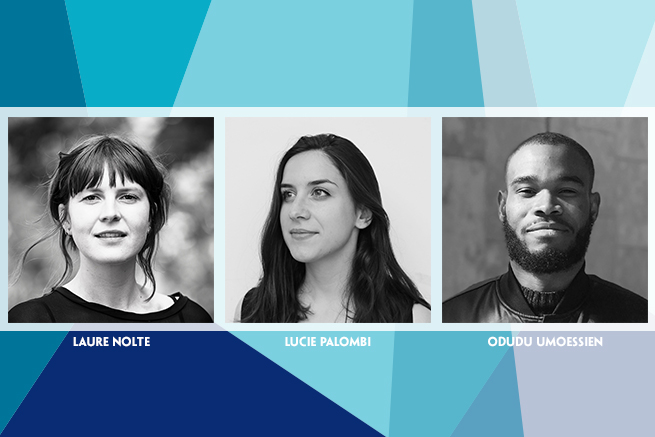
OTTAWA, July 18, 2019 – The Royal Architectural Institute of Canada (RAIC) and the RAIC Foundation are pleased to announce the three winners of the 2019 RAIC International Prize Scholarships.
They are:
- Laure Nolte, Dalhousie University
- Lucie Palombi, University of Montreal
- Odudu Umoessien, University of Manitoba
Each student has won a $5,000 scholarship for writing an essay describing the moment they decided to become an architect or knew their decision to become an architect was the right one.
Click here for essays and images.
The RAIC International Prize Scholarships are presented in conjunction with the $100,000 RAIC International Prize. The winner of the RAIC International Prize, to be selected from a shortlist of three projects from Senegal, Peru, and Chile, will be announced at the RAIC International Prize Gala on October 25 in Toronto, ON. The scholarship winners will receive their awards at the same event.
Tickets for the 2019 gala are available for sale here.
The RAIC received 93 eligible entries in both English and French from students enrolled in Canada’s 11 accredited schools of architecture as well as students at the RAIC Centre for Architecture at Athabasca University and the RAIC Syllabus Program.
“These essays describe moments when their authors understood the world through architecture and formed their own wish to be an architect,” says RAIC President Michael Cox, FRAIC. “Gathering with people, travelling, reading – all are enriched by the places where they occur. In very different ways, the essays evoke the value given by the built world to our lives, and the wish of architects to contribute.”
Lucie Palombi’s essay adopts the form of a letter to Le Corbusier. She writes about being inspired by the travels he recounted in published journals. Through the descriptions of North America in the 19th century, Paris in the 20th, and the Gardens of Versailles, Palombi ponders the question: “Can we shape the world with words on paper?” As she journeys to these far-off locations from her library, Palombi learns that stories– real or fictional –give life to places.
Jury comment: The essay was astute and original in form and content, as well as beautifully written. It indicated a fresh and probing new mind capable of contributing to the discipline in thought and deed.
Laure Nolterecounts “uncomfortable” visits with her mother in a long-term care facility after she developed multiple sclerosis. “Weaving my core values around the awareness of design’s ability to enhance emotional and physical healing has been my call to action to the field of architecture,” she writes. By delving into current research, Nolte looks at how architecture can, through design, ambiance, and materials used, improve quality of life and support healing, especially for those in institutional settings.
Jury comment: This submission expanded outward from a personal experience of illness…to a broader reflection on the meaning and impact of architecture on human well being, as well as the interplay of human cognition and built space.
In an essay about his childhood in Nigeria, Odudu Umoessien writes about becoming “consumed by the relationship between people and space” after seeing the love people had for a courtyard used for storytelling. Later, observing the construction of classrooms in a village, he saw the community begin to identify with the structure as they built it together. It brought joy, pride, and hope. “The people were self-confident: they saw themselves in that piece of architecture.”
Jury comment: The submission was well-conceived and succinct in its portrayal of an individual journey towards an understanding of the possibilities of meaning (as well as purpose) for architecture and community.
Amal Dirie will receive a Certificate of High Merit for her essay, focusing on the temporary dwellings built by nomadic people in Somalia. The ingenuity and care visible in the creation of these huts, always built by women, demonstrate the paradoxes of displacement, nomadism, and the wish for the hut to be more than a basic shelter.
Jury Comment: It demonstrated a keen mind committed to seeing and understanding the rich interrelationship of people and architecture, regardless of material circumstances.
The 2019 jury members are:
- Elsa Lam, FRAIC, editor of Canadian Architect magazine;
- Anne Bordeleau, MRAIC, director, School of Architecture, University of Waterloo;
- Douglas MacLeod, FRAIC, chair, RAIC Centre for Architecture, Athabasca University;
- André Perrotte, FIRAC, partner, Saucier + Perrotte Architectes;
- Barry Sampson, FRAIC, principal, Baird Sampson Neuert Architects;
- David Covo, FRAIC, associate professor, Peter Guo-hua Fu School of Architecture, McGill University.
ABOUT THE RAIC
The Royal Architectural Institute of Canada is the leading voice for excellence in the built environment in Canada. Representing about 5,000 members, the RAIC advocates for excellence, works to demonstrate how design enhances the quality of life and promotes responsible architecture in addressing important issues of society.



